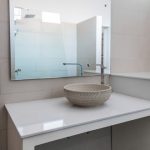1. The Importance of Natural Lighting in Modern Architecture
Natural lighting plays a crucial role in modern architectural design, offering numerous benefits that go beyond mere aesthetics. Architects and designers are increasingly integrating natural light into buildings to enhance energy efficiency, improve occupant well-being, and create visually appealing spaces. Understanding these advantages can help shape the future of sustainable and innovative architectural designs.
Energy Efficiency and Sustainability
One of the most significant benefits of natural lighting is its impact on energy consumption. By maximizing daylight use, buildings can reduce their reliance on artificial lighting, leading to lower electricity costs and decreased carbon footprints. This approach aligns with sustainable design principles and supports global efforts to create more eco-friendly living and working environments.
| Benefit | Description |
|---|---|
| Reduced Energy Costs | Less reliance on artificial lighting lowers electricity bills. |
| Lower Carbon Footprint | Decreased energy consumption contributes to environmental sustainability. |
| Enhanced Indoor Comfort | A well-lit space reduces the need for excessive heating or cooling. |
Impact on Occupant Well-Being
The presence of natural light in indoor spaces has been proven to enhance physical and mental well-being. Studies show that exposure to sunlight helps regulate circadian rhythms, improves mood, and increases productivity. In workplaces, schools, and healthcare facilities, incorporating ample daylight can lead to better performance, reduced stress levels, and an overall healthier environment.
Mental and Physical Health Benefits
- Mood Enhancement: Sunlight triggers serotonin production, which boosts happiness and reduces depression.
- Better Sleep Patterns: Exposure to natural light during the day helps regulate sleep cycles at night.
- Increased Productivity: Bright and well-lit environments contribute to higher focus and efficiency.
Aesthetic Appeal in Architectural Design
Beyond functionality, natural lighting significantly enhances the visual appeal of a space. It creates dynamic interiors by changing the perception of colors, textures, and spatial depth throughout the day. Architects use strategic window placements, skylights, and reflective surfaces to maximize daylight penetration while maintaining a balanced aesthetic composition.
The Role of Light in Interior Atmosphere
- Dramatic Shadows: Natural light interacts with architectural elements to create striking visual effects.
- Sense of Openness: Well-lit spaces feel larger and more inviting.
- Naturally Highlighted Features: Sunlight enhances design details like wood grains, stone textures, and glass reflections.
2. Advancements in Smart Glass and Dynamic Windows
As architectural design continues to evolve, smart glass and dynamic windows are becoming essential components in creating energy-efficient and sustainable buildings. These advanced glazing technologies can adapt to environmental conditions, optimizing natural lighting while reducing energy consumption.
How Smart Glass Technology Works
Smart glass, also known as switchable glass or dynamic glazing, uses different technologies to control light transmission. Depending on the type of smart glass used, it can change its transparency in response to external factors such as light, heat, or electricity.
Types of Smart Glass
| Type | Functionality |
|---|---|
| Electrochromic Glass | Changes tint when voltage is applied, allowing gradual light control. |
| Thermochromic Glass | Adjusts transparency based on temperature changes. |
| Photochromic Glass | Darkens in response to UV exposure, similar to transition lenses. |
| Suspended Particle Devices (SPD) | Tint level adjusts instantly by controlling suspended particles with an electrical charge. |
| Polymer Dispersed Liquid Crystal (PDLC) | Switches between transparent and opaque states for privacy applications. |
The Role of Smart Glass in Sustainable Design
The integration of smart glass in architecture offers significant benefits for sustainability. By adjusting transparency levels dynamically, these windows reduce reliance on artificial lighting and HVAC systems, leading to lower energy consumption. This contributes to a building’s overall energy efficiency and supports green building certifications such as LEED.
Key Benefits of Smart Glass
- Energy Efficiency: Reduces heat gain and loss, lowering cooling and heating costs.
- Enhanced Comfort: Maintains optimal indoor lighting and temperature without manual adjustments.
- Glare Reduction: Minimizes glare from direct sunlight, improving visual comfort in workspaces.
- Aesthetic Appeal: Provides sleek, modern window solutions that enhance building design.
- Sustainability: Supports eco-friendly construction by decreasing reliance on artificial energy sources.

3. Harnessing Daylight with Innovative Skylights and Light Tubes
Maximizing natural light while maintaining energy efficiency is a key goal in modern architectural design. Skylights and tubular daylighting devices (TDDs) offer innovative ways to bring sunlight into interior spaces without excessive heat gain. These solutions enhance indoor lighting, reduce reliance on artificial illumination, and contribute to a more sustainable built environment.
Understanding Modern Skylights
Skylights have evolved significantly, incorporating advanced materials and designs that optimize daylight penetration while minimizing unwanted solar heat. Modern skylights often feature:
- Low-E Glass Coatings: Reduces infrared and ultraviolet light penetration, keeping interiors cooler.
- Operable Designs: Allows for natural ventilation, improving indoor air quality.
- Smart Controls: Automated shading systems that adjust based on sunlight intensity.
Tubular Daylighting Devices (TDDs)
TDDs, also known as light tubes or sun tunnels, are compact yet highly effective solutions for delivering natural light into areas where traditional windows or skylights are impractical. These devices consist of three main components:
| Component | Description |
|---|---|
| Dome | A rooftop collector that captures sunlight efficiently. |
| Reflective Tube | A highly reflective tunnel that directs daylight deep into the building. |
| Diffuser | An interior fixture that disperses soft, even illumination throughout the room. |
The Benefits of Skylights and TDDs
The integration of these daylighting solutions offers multiple advantages, including:
- Energy Savings: Reduced need for artificial lighting lowers electricity consumption.
- Improved Well-Being: Increased exposure to natural light enhances mood and productivity.
- Sustainable Design: Supports eco-friendly building practices by reducing carbon footprints.
Selecting the Right Solution for Your Space
The choice between skylights and TDDs depends on factors such as roof structure, climate conditions, and specific lighting needs. While skylights work well in open-plan areas, TDDs are ideal for smaller or enclosed spaces where conventional windows cannot be installed.
4. Integrating Nature: Biophilic Design and Sunlight Optimization
Biophilic design is a growing trend in architecture that focuses on incorporating natural elements into built environments. By using biophilic principles, architects can enhance natural lighting, improve indoor air quality, and create spaces that promote well-being. One of the key aspects of this design approach is optimizing sunlight to make interiors feel more connected to the outdoors.
How Biophilic Design Enhances Natural Lighting
Architects use various strategies to integrate natural light seamlessly into spaces. These strategies not only reduce the need for artificial lighting but also contribute to a healthier and more inviting atmosphere.
Key Strategies in Sunlight Optimization
| Strategy | Description |
|---|---|
| Large Windows and Glass Walls | Maximizes daylight penetration while providing outdoor views. |
| Skylights and Light Wells | Brings natural light into deeper sections of a building. |
| Reflective Surfaces | Enhances light distribution by bouncing sunlight throughout the space. |
| Greenery Integration | Uses plants and living walls to soften light and improve air quality. |
| Smart Shading Systems | Adjusts automatically to optimize light levels and reduce glare. |
The Benefits of Natural Light in Indoor Spaces
Natural lighting has numerous benefits beyond aesthetics. It can boost mood, enhance productivity, and even support better sleep patterns. Additionally, increased exposure to daylight reduces reliance on artificial lighting, leading to energy savings.
Creating Healthier Environments with Sunlight
The integration of natural light through biophilic design has been linked to improved mental health, reduced stress levels, and greater overall comfort. When combined with sustainable materials and smart technologies, buildings can become more efficient while maintaining a strong connection to nature.
Future Trends in Biophilic Lighting Design
As technology advances, architects are finding new ways to optimize sunlight in buildings. Innovations such as dynamic glass, solar-responsive facades, and AI-driven lighting systems will continue to shape the future of natural lighting in architectural design.
5. Future Trends in Natural Lighting for Sustainable Architecture
As architectural design continues to evolve, natural lighting is becoming an essential element in creating sustainable and energy-efficient buildings. New technologies and innovative strategies are shaping the way natural light is integrated into modern structures, improving both functionality and aesthetics.
Smart Glass and Dynamic Glazing
One of the most promising advancements in natural lighting is smart glass technology. This dynamic glazing system allows windows to automatically adjust their tint based on sunlight intensity, reducing glare and heat gain while maintaining optimal daylight levels.
| Technology | Function | Benefits |
|---|---|---|
| Electrochromic Glass | Changes tint with electrical signals | Reduces energy consumption, improves comfort |
| Thermochromic Glass | Adjusts tint based on temperature | No electricity required, enhances passive cooling |
| Photochromic Glass | Darkens in response to UV light | Enhances daylight control, reduces glare |
Advanced Daylighting Systems
Future buildings will incorporate advanced daylighting systems that maximize natural light distribution while minimizing energy use. Technologies such as light shelves, prismatic panels, and fiber optic daylighting can direct sunlight deep into interiors, reducing dependence on artificial lighting.
AI-Driven Lighting Optimization
The integration of artificial intelligence (AI) in building design is revolutionizing how natural light is managed. AI-driven lighting systems analyze real-time data to optimize window shading, adjust interior lighting levels, and enhance occupant comfort.
Key Features of AI-Driven Lighting:
- Sensors monitor natural light levels throughout the day.
- Automated shading adapts to changing weather conditions.
- A predictive system adjusts indoor lighting based on occupancy patterns.
Sustainable Building Materials Enhancing Light Reflection
The use of high-reflectivity materials in ceilings, walls, and floors can help distribute natural light more effectively. Materials such as reflective paints, translucent concrete, and mirrored surfaces increase daylight penetration without excessive heat gain.
Examples of High-Reflectivity Materials:
- Translucent Concrete: Allows diffused natural light to pass through walls.
- Light-Diffusing Panels: Evenly spread sunlight across interiors.
- Spectrally Selective Coatings: Improve daylight efficiency while blocking unwanted heat.
The Role of Biophilic Design in Natural Lighting
The future of architectural design emphasizes biophilic principles—integrating nature-inspired elements to enhance human well-being. Features such as large skylights, green walls with reflective surfaces, and atriums filled with natural light create healthier indoor environments.
Benefits of Biophilic Design:
- Improves mental health by increasing exposure to natural elements.
- Cuts down energy costs by maximizing daylight utilization.
- Cultivates a stronger connection between indoor spaces and nature.
The future of natural lighting in architecture is driven by innovation and sustainability. With emerging technologies like smart glass, AI-driven optimization, and biophilic design principles, buildings will become more efficient, comfortable, and environmentally responsible.


